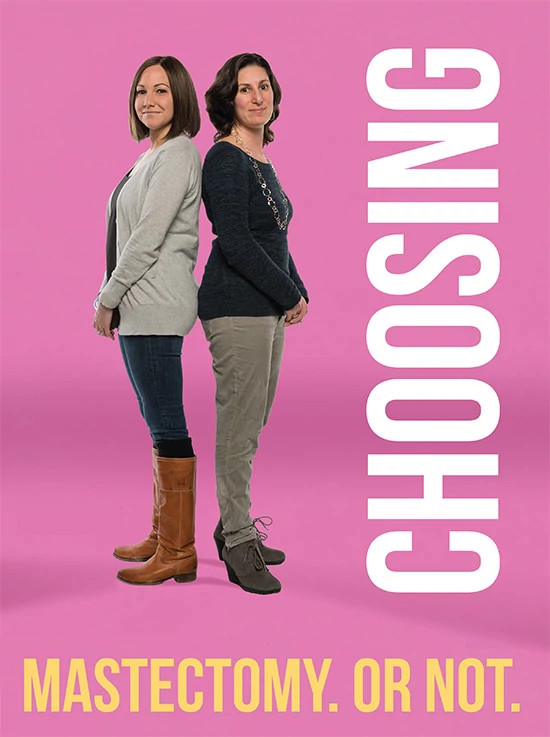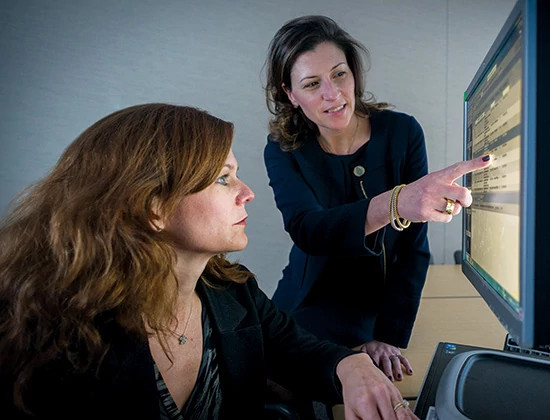Choosing Mastectomy. Or Not.
From Turning Point 2016

by Elizabeth Dougherty
A growing number of breast cancer patients, particularly young women, are choosing bilateral mastectomy (removal of both breasts) to treat or prevent cancer, even when it is not medically advised. Rates have jumped six-fold between 1998 and 2011, and eleven-fold among women under age 40, according to a recent study in the Journal of the American Medical Association.
Why are young women choosing more surgery when less is a viable option? Reasons are beginning to emerge through research led by Ann Partridge, MD, MPH, director of the Program for Young Women with Breast Cancer at the Susan F. Smith Center for Women's Cancers at Dana-Farber. In surveys, patients report knowing that, statistically, bilateral mastectomy will not improve survival, yet they say they choose it for peace of mind. "They don't connect the statistics to their own experience," Dr. Partridge says.
Further research suggests that the disconnect may be related to the anxiety women feel when they receive a breast cancer diagnosis. Study data can be hard to hear when women are laser-focused on doing everything possible to eliminate their cancer and prevent it from coming back.
"Our job is to help women take a step back," says Tari King, MD, chief of breast surgery at the Susan F. Smith Center. "Sit down, take a deep breath and talk about it. Bilateral mastectomy is not a decision to be made lightly."
Bilateral mastectomy is major surgery with long-term consequences. The procedure causes a woman to lose sensation in the skin over her chest area. Women may also experience changes in posture or range of arm motion. And, while mastectomy is a safe operation, every surgery comes with a risk of complications. Even more worrisome, complications can delay important follow-up treatment, such as chemotherapy or radiation.
"Women sometimes feel like their breasts are the enemy," says Dr. King. "They think they need to get rid of them to solve the problem. As physicians, we need to make sure they understand the risks and benefits of the procedure."
So when is mastectomy advisable for a breast cancer patient, and when is it not? It depends. For women with metastatic tumors, mastectomy is not recommended, explains Dr. King, but it might be a good choice for early stage tumors that are large or directly behind the nipple.
"For women who are good candidates for breast-conserving lumpectomy, there is no difference in survival between keeping the breast or removing it," Dr. King says.
A Good Candidate for Mastectomy
At age 33, Amanda Skypeck learned that several relatives on her father's side not only had been treated for breast cancer, but also tested positive for a BRCA gene mutation. This mutation increases a woman's lifetime risk of getting breast cancer seven-fold, according to the Centers for Disease Control and Prevention.

In January 2015, Skypeck learned that she, too, carried the mutation. A genetic counselor explained to her that many BRCA-positive women opt for a bilateral mastectomy as a preventive measure. "I knew immediately that I wanted to do that," says Skypeck.
Skypeck is part of a high-risk population of women that includes BRCA mutation carriers and women who had mantle radiation during adolescence for a different kind of cancer. "Mastectomy substantially reduces the risk of breast cancer for these women," says Dr. King. "The risks and benefits start to tip the scale in favor of surgery."
Skypeck, a school guidance counselor, was considering scheduling her surgery over the summer when her doctor found a lump. It was breast cancer. She had a bilateral mastectomy right away, followed by chemotherapy and breast reconstruction. She now goes back every six months for screening and a physical exam, because mammography is not indicated after reconstruction.
Everything went smoothly for Skypeck, but it is not always so. Doctors are beginning to notice a pattern. Women who undergo this major surgery sometimes struggle with post-surgical treatment.
"Sometimes, they have a harder time with chemotherapy, or they experience delays because of surgical complications," says Dr. Partridge. "Sometimes, they stop hormone therapy to undergo reconstruction. More research needs to be done to look at the downstream effects of taking on more surgery."
Learn more about BRCA1 and BRCA2 alterations and link to breast cancer.
When Breast Conserving Surgery Is Right
In 2010, when she was age 37, Judy Rosenbaum had a mammogram to ease her mind about breast cancer. Abnormalities in the results brought her back for more testing, repeated every six months.
After two years and no changes, Rosenbaum thought she was in the clear. Then, she found a lump. After more tests and a biopsy, she learned she had breast cancer.
Rosenbaum, a church administrator, had no family history of breast cancer and, after genetic testing, found she had no increased risk for the disease. She considered her surgical options: mastectomy or lumpectomy. Dr. Partridge explained that for women with similar cases, studies show lumpectomy plus radiation yields the same long-term survival rates as mastectomy.
Rosenbaum chose lumpectomy. "I didn't want a mastectomy," she says. "I was worried that it's a really big surgery and I'd still need reconstructive surgery later."

While Rosenbaum's decision is the most common, women like her are increasingly choosing to remove both breasts, even though lumpectomy plus radiation and/or chemotherapy has the same long-term benefits and substantially lower short-term risks. Women making this choice seem to be motivated by worries about getting breast cancer in the remaining healthy breast, says Dr. Partridge. However, the greatest risk is that the original cancer will return in another part of the body, such as the lungs or liver. Bilateral mastectomy does not reduce that chance.
"Many young women with breast cancer don't believe in statistics anymore," says Dr. Partridge. "I tell them the odds are that they won't get it again. They look at me and say, 'I wasn't supposed to get it in the first place.' They feel like they have a bull's-eye on their backs."
Driving Informed Decisions
In a recent study of young women with breast cancer, Dr. Partridge and Dana-Farber epidemiologist Shoshana Rosenberg, ScD, MPH, found that higher levels of anxiety were associated with the choice of bilateral mastectomy over lumpectomy or single mastectomy.
Dr. Rosenberg is now leading a study to dig deeper into the factors that influence women's decisions about surgery. She plans to use her findings to develop better tools to guide women through the decision-making process. Such tools could include visual aids to help doctors clearly communicate risks and benefits, but they might also include anxiety management resources to help women manage their emotions while making this important choice.
"Our goal is to present information in a way that will help women process and understand it," says Dr. Rosenberg. "We want to make sure they're making decisions for the right reasons."
Three years after her lumpectomy, Rosenbaum has regular checkups and mammograms. She still wonders if she made the right choice. "I guess there's no way you can know," she says. "But I'm really happy with the decisions I made."
Skypeck is also happy with her decision, yet not completely at peace. "The psychology behind it is very interesting," she says. "I've had such thorough treatment, but it's still frightening to think about my cancer coming back."
For more information, watch Breast Cancer Surgery: Lumpectomy vs. Mastectomy.
Supporting Young Women
The Susan F. Smith Center for Women's Cancers has a dedicated program for young women with breast cancer that offers resources, education, and opportunities to participate in research studies. Visit online or follow @youngstrongDFCI on X, formerly known as Twitter.
Request a Publication
Receive by mail the current issue of a Dana-Farber publication by completing this request form.
Media Contacts
If you are a journalist and have a question about any of our stories or need more information, email media@dfci.harvard.edu or call 617-632-4090 and ask to speak to a member of the media team.
The Media Team cannot respond to patient inquiries. For more information on contacting Dana-Farber, please see Contact Us.